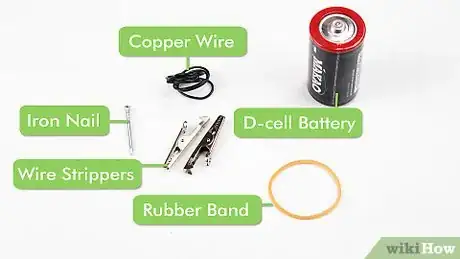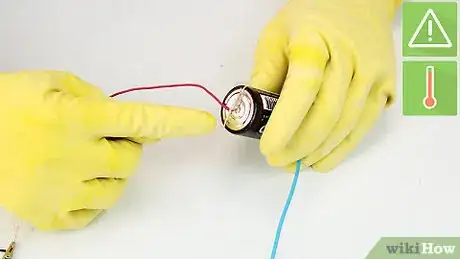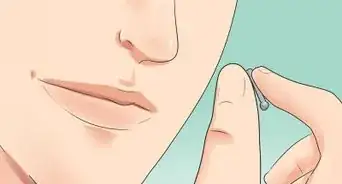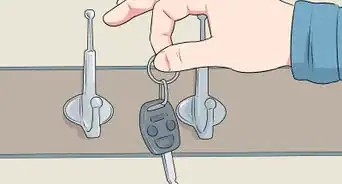This article was co-authored by wikiHow Staff. Our trained team of editors and researchers validate articles for accuracy and comprehensiveness. wikiHow's Content Management Team carefully monitors the work from our editorial staff to ensure that each article is backed by trusted research and meets our high quality standards.
The wikiHow Video Team also followed the article's instructions and verified that they work.
This article has been viewed 136,353 times.
An electromagnet is a classic science experiment often made in a classroom setting. The idea is to turn a common iron nail into a magnet with the help of copper wire and a battery. An electromagnet works by transferring electrons, which are subatomic particles that carry a negative charge, from the battery into the copper wire. When these electrons are flowing, they create a magnetic force around the nail. It allows the nail to function as a magnet, picking up small metallic objects like paper clips.[1] With a little patience and effort, you can make an electromagnetic battery of your own.
Steps
Preparing the Wire
-
1Gather your materials. Before you can make an electromagnet, take a moment to gather your materials. You will need the following:
-
2Remove the insulation from the copper wire. Copper wires are usually coated in a layer of plastic for insulation purposes. This is to protect users from electric shock. However, the battery cannot transfer electrons to the wire through the insulation. The coating needs to be removed.
- Using your wire strippers, remove a few centimeters of insulation from each end of the wire.[4]
- Wire clippers look like a pair of scissors with a hole cut out in the middle. You feed the wire through this hole and pull the clippers across the wire to strip the insulation. You should get a wire stripper that's small enough to strip a very small bit of copper wire.[5]
-
3Wrap the wire around the nail. Once you've prepared the wire, you can begin building your battery. To start, neatly wind the wire around your nail. The smaller loops you use, the stronger your battery will be. Be careful to leave enough wire on either end. You'll be attaching the excess wire to your battery, so it's a good idea to leave about 8 inches of loose wire on each end.[6]
Connecting the Battery
-
1Connect the battery. Once you're done wrapping the wire, connect either ends of the wire to the battery. Connect one end to the negative side and one end to the positive side. Make sure the portions of the wire that have been stripped of insulation are the ends touching the battery. Use your rubber band to strap the wires in place by wrapping the rubber band around the battery from the negative end to the positive end.[9]
- It does not matter which end of the wire is connected to which end of the battery. It will work either way.[10]
- If a rubber band is not holding the wires in place, you can use two pieces of masking tape instead.
-
2Test the electromagnet. You should now have successfully created an electromagnetic. To test the magnet, hover the battery over a metallic item like a paper clip. The paperclip should rise up and attach to the battery. You have created a magnetic charge with the wire, nail, and battery.[11]
- If you want to increase the strength of your battery, increase the number of coils running around your nail. This will allow your electromagnet to pick up more objects.[12]
-
3Fix any issues. In the event your magnet does not work, check the battery. A dead or low charge battery may not be effective in creating an electromagnet. If the battery is fine, review your process. You may have curled the wire in opposite directions, disrupting the flow of electrons. You may also have forgotten to remove the insulation from the wire.
Taking Safety Precautions
-
1Use gloves when handling your magnet. Always use gloves when you begin experimenting with your magnet. Wires can get hot when in use. You want to make sure you do not burn your hands when handling your electromagnet. This is especially vital if you're working on strengthening your magnet. Electromagnets get hot as their strength increases.[13]
-
2Be conscious of heat. As stated, electromagnets get hot when you increase their strength by wrapping the wire tighter. If the device becomes very hot, you might want to disconnect the wires to deactivate the magnet for a bit. Excessive heat can cause burns and, in rare cases, may be a fire hazard.[14]
-
3Disconnect the wires when you're done with your magnet. You should not leave an electromagnet plugged in for long when it's not in use. For one, the battery can drain the magnet swiftly. Also, once again, heat is a concern. Once you're done playing with your magnet, disassemble it.[15]
Community Q&A
-
QuestionWhat happens to an iron atom when an electromagnet attracts it?
 Community AnswerIf the electromagnet attracts it in one direction about 60 times, it magnetizes.
Community AnswerIf the electromagnet attracts it in one direction about 60 times, it magnetizes. -
QuestionWill this work with a normal battery?
 Community AnswerYes, if the battery is over 2 volts in power. You can use 2 AAs or 1 C or D battery.
Community AnswerYes, if the battery is over 2 volts in power. You can use 2 AAs or 1 C or D battery. -
QuestionDoes an electromagnet have the capability of stopping an object that is revolving at 1500 rpm?
 Community AnswerThat depends on the strength of the magnet and whether the revolving object is magnetic.
Community AnswerThat depends on the strength of the magnet and whether the revolving object is magnetic.
References
- ↑ http://wonders.physics.wisc.edu/build-an-electromagnet.htm
- ↑ http://education.jlab.org/qa/electromagnet.html
- ↑ https://www.teachengineering.org/view_activity.php?url=collection/cub_/activities/cub_mag/cub_mag_lesson2_activity1.xml
- ↑ http://education.jlab.org/qa/electromagnet.html
- ↑ http://boingboing.net/2014/06/02/guide-to-wire-strippers.html
- ↑ https://sciencebob.com/make-an-electromagnet/
- ↑ http://education.jlab.org/qa/electromagnet.html
- ↑ http://education.jlab.org/qa/electromagnet.html
- ↑ https://www.teachengineering.org/view_activity.php?url=collection/cub_/activities/cub_mag/cub_mag_lesson2_activity1.xml
- ↑ http://education.jlab.org/qa/electromagnet.html
- ↑ https://www.teachengineering.org/view_activity.php?url=collection/cub_/activities/cub_mag/cub_mag_lesson2_activity1.xml
- ↑ https://www.teachengineering.org/view_activity.php?url=collection/cub_/activities/cub_mag/cub_mag_lesson2_activity1.xml
- ↑ https://www.teachengineering.org/view_activity.php?url=collection/cub_/activities/cub_mag/cub_mag_lesson2_activity1.xml
- ↑ https://www.teachengineering.org/view_activity.php?url=collection/cub_/activities/cub_mag/cub_mag_lesson2_activity1.xml
- ↑ https://sciencebob.com/make-an-electromagnet/
- Videos provided by Tinker Crate by Kiwi Crate, Inc.
























